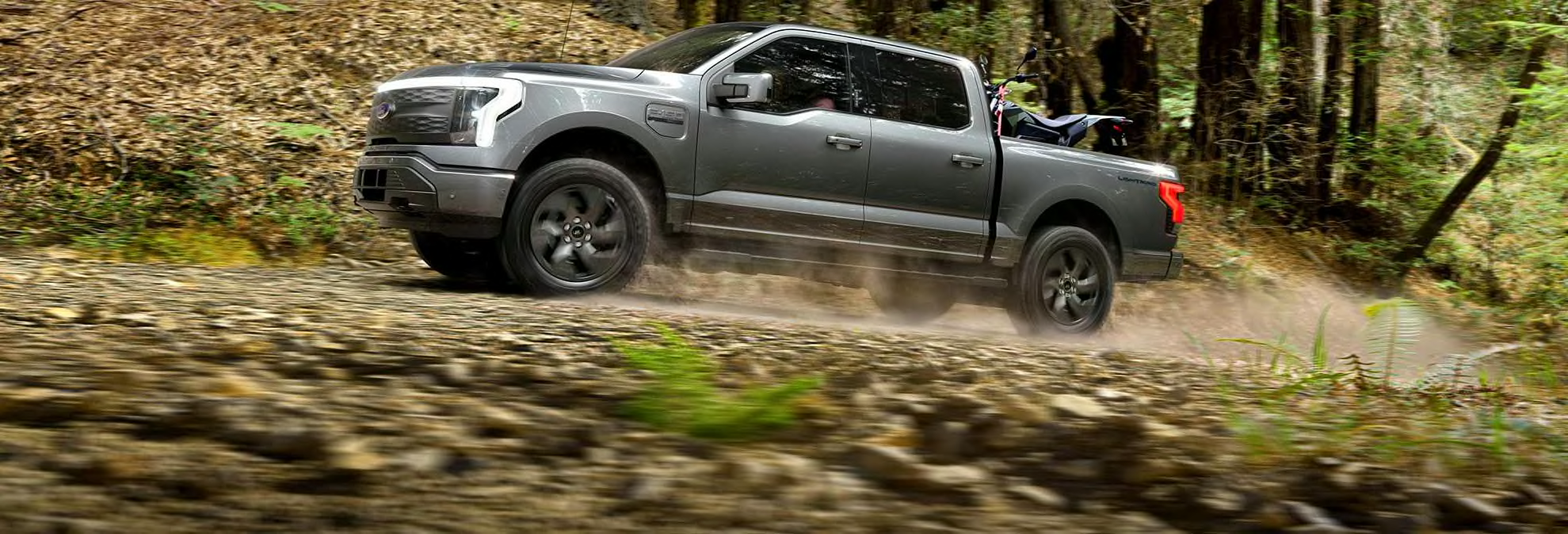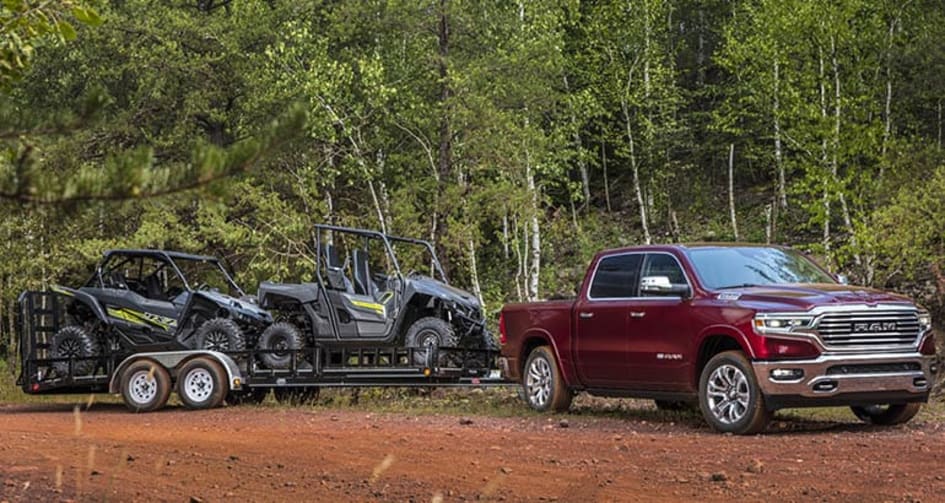
Pickup Truck Buying Guide

Managing Editor, Autos
Trucks are no longer just single-purpose work vehicles. They’re often used as day-to-day family haulers, serving varied roles from basic transportation to towing vehicles for weekend recreation. Ongoing advancements have helped them become command centers for commercial users and aspirational vehicles for buyers who crave an exclusive luxury vehicle.
Modern rigs are still big, bold, and highly capable. They’re also being equipped with more safety, convenience, and comfort features than ever before.
High points for today’s trucks include:
- Many freshened and redesigned models are bringing the latest modern features to trucks.
- A variety of powertrains are available, including regular gas, diesel, hybrid, and electric.
- More compact models are being offered, showing improved fuel economy.
- Larger, full-frame models have the highest towing and hauling capabilities.
There are seemingly endless combinations of trim choices, bed sizes, engine options, and exterior and interior color palettes. Keep in mind that when you start configuring a new truck, it’s easy to buy way more machine than you’ll use. Planning a truck purchase can be tricky, so it’s best to be honest about how you’re going to use it. For example, if you have no plans to carry large loads or pull a very heavy trailer, there probably is no need for a heavy-duty pickup truck; a lighter-duty full-sized truck, or even a compact or midsized pickup, could fit the bill.
Pickups differ greatly not only in size but also in price, fuel economy, comfort, performance, safety, and reliability. Some of these factors are connected: The trucks with the best fuel economy typically weigh less, are smaller, and have less powerful engines. Likewise, we find that the more heavy-duty a truck is, the worse the ride gets.
There has never been a better time to be in the truck market, because there’s something for everyone. But although choices have never been more prolific, prices have steadily crept up. Here’s a guide to help you get the most for your truck dollar.
Pickup Truck Types
Compact trucks are usually the least expensive way to join the club, and they are offered by many manufacturers. Full-sized pickups, sometimes called half-ton trucks, are by far the biggest-selling type. These carry the designation 1500 in the case of the Chevrolet Silverado, GMC Sierra, and Ram, and Ford refers to its popular offering as the F-150. Toyota also offers the Tundra. Heavy-duty trucks are designated 2500 and 3500 (or F-250 and F-350, respectively), with the larger numbers conveying greater capabilities in terms of towing and payload. And the larger the number, the more commercial-focused the truck becomes. That being said, these brands do offer luxury-oriented trims of their heavy-duty models.
As with all types, buyers can choose regular two-door cabs, extended cabs with limited second-row seating, and roomy four-door crew-cab body styles; two-, four-, or all-wheel drive; and tons of engine and transmission combinations.
Compact Pickup Trucks
This pickup truck category consists of the Chevrolet Colorado (and its corporate cousin, the GMC Canyon), Ford Maverick, Ford Ranger, Honda Ridgeline, Hyundai Santa Cruz, Jeep Gladiator, Nissan Frontier, and Toyota Tacoma.
Most are built using body-on-frame construction like their full-sized brethren, and they usually offer a range of four-cylinder and V6 engines. The Ridgeline, Maverick, and Santa Cruz use unibody construction, borrowing underpinnings from crossover SUVs in each automaker’s lineup. This gives them more car-like ride and handling characteristics compared with body-on-frame models.
What you’ll spend: Prices for the most compact trucks start around $27,000 for a basic 2WD Maverick. At the other extreme, a top-trim Gladiator can run more than $55,000. Most middle-ground, 4WD crew-cab versions that CR has tested came in around $38,000 to $42,000.
Full-Sized Pickup Trucks
These are the brawny workhorses of the pickup world. They’re larger and more rugged, and they ride higher off the ground than compacts. Current models in this class include the Chevrolet Silverado 1500, Ford F-150, GMC Sierra 1500, Ram 1500, and Toyota Tundra. Electric trucks include the Chevrolet Silverado EV, Ford F-150 Lightning, GMC Hummer EV, GMC Sierra EV, Ram 1500 REV, Rivian R1T, and Tesla Cybertruck. On the horizon is the small Slate Truck and the Scout Terra.
Full-sized trucks form the backbone of the pickup market. They serve well as work trucks and, for many, as a substitute for the family car. Powertrain choices vary from turbocharged four-cylinders, V6s, old-school V8s, full hybrids, and even all-electric power.
What you’ll spend: Most decently equipped crew-cab models with 4WD cost between $50,000 and $65,000. Adding any of the available turbodiesel engines raises the price considerably. Of course, there are multiple ways to break the bank with these trucks, with high-priced, premium trim levels and many choices for packages and accessories. Prices can soar to $80,000 and beyond.
Heavy-Duty Trucks
These supersized trucks carry numerical designations such as 2500 or 3500. They are configured for muscling serious loads and for hauling fifth-wheel trailers that connect to a hitch point in the center of the cargo bed. These are bulky trucks for the most demanding chores, making them overkill for most noncommercial purposes shy of hauling a huge trailer. Only Detroit competes in this heavyweight division.
What you’ll spend: A no-frills, 2WD, regular-cab, 2500-series work truck starts at around $45,000 before options. And a fully loaded, top-end, 4WD crew-cab model with a diesel engine can reach the $100,000 mark. Add even more for the 3500s.

Photo: John Powers/Consumer Reports Photo: John Powers/Consumer Reports
Factors That Pickup Truck Buyers Should Consider
Cab Size and Seating
Regular cabs have only front-row seating and are the least expensive to buy, but they tend to be available only in basic, work-oriented configurations. Extended cabs are far more useful due to their small rear seat and set of shortened rear doors. Crew cabs are the most popular configuration and provide the roomiest interior accommodations, especially in full-sized trucks.
Pickup trucks are among the only vehicles left that can be configured to seat three across in the front seat. Rear seats in extended-cab trucks can be cramped for adults, with limited legroom, though they’re often acceptable for kids. The real advantage of an extended cab is additional interior storage. Crew-cab trucks have four full-sized doors and a rear seating (or cargo) area on a par with midsized and full-sized SUVs, but these large cabs usually come with a smaller cargo bed.
As you move up the trim lines, cloth seats turn into leather, and heated and cooled seats with increasing levels of adjustability become a given for the top trims. Other optional creature comforts include heated steering wheels, enormous touchscreen infotainment systems, and massive sunroofs that make high-roller truck buyers feel like they’re driving in the lap of luxury. However, getting into many of these cabs can be a hike; even with available running boards, it’s a steep climb up into most trucks.
The Bed
This is, of course, what sets trucks apart from all other vehicles. The open cargo bed lends itself to accomplishing serious chores, such as moving large appliances, bulky furniture, tools or equipment, motorcycles, snow blowers, and outdoors-only cargo like wood chips, manure, and trash. These are tasks most people wouldn’t want to (or couldn’t) do with a minivan or an SUV. Among other considerations, the open bed leaves cargo vulnerable to weather or theft.
The average bed length in a full-sized pickup is 6 feet, but it can go up to 8 feet, usually with a regular or extended cab. Four-door crew cabs can generally be had with a 5- or 6-foot bed. Compact pickup beds usually run 4½ to 6 feet, depending on cab configuration. Do consider how you will use the bed, and how often, because this may guide some major decisions.
There are many bed accessories available, including LED lights, a tailgate step, stowable load ramps, tie-down loops, stake pockets, and remote tailgate releases. Some even come with power-operated tailgates. Spray-in and drop-in liners are popular for added protection when hauling items in the bed.
The tailgate has become a differentiating factor among trucks. The Honda Ridgeline comes with a dual-action tailgate, which allows it to flip down like a conventional tailgate or swing sideways like a door. The Silverado and Sierra are available with a tailgate that can act as a step, a work surface, or even an extension of the bed itself. Ford has added locations for clamping building materials to the tailgate of the F-150. Most or all of these features are offered by just about every brand.
Engines and Fuel Economy
Engines range from small four-cylinders and V6s to V8s and big diesels. For top marks in fuel efficiency, look no further than the Maverick hybrid, which delivered 37 mpg overall in our tests—the best by far of any other pickup.
Ford offers a hybrid F-150 with a powerful 3.5-liter turbocharged V6. In our tests, it returned 20 mpg overall in a crew cab, four-wheel-drive model—just 1 mpg better than Ford’s 2.7-liter V6. The 1500-series diesel engines from GM and Ram also rank high, with 23 mpg overall.
Heavy-duty trucks are built for working hard. They create a lot of power and torque, with fuel economy around 14 to 16 mpg overall for the big rigs.
All-electric trucks offer yet another powertrain option. See our model pages for detailed information on the CR-tested range results. Our testing revealed that towing a heavy trailer can significantly reduce range. Electric trucks are well suited to certain duties, such as in-state driving and worksite power sources. But other tasks, like interstate travel with a large trailer, are best done in trucks with conventional engines.
2WD vs. AWD vs. 4WD
Most trucks are rear-wheel or four-wheel-drive, but unibody models like the Ford Maverick, Honda Ridgeline, and Hyundai Santa Cruz use a front-drive platform and are available with all-wheel drive.
AWD and 4WD provide power to all wheels, but even though they sound similar, they’re not quite the same thing. AWD is a lighter-duty system that stays permanently engaged or one that uses a clutch pedal system to automatically route power between the front and rear wheels as needed. Some newer systems allow the driver to make their own adjustments via drive modes or differential locks. AWD is usually fine for typical adverse weather conditions and tackling dirt roads.
Trucks with traditional 4WD usually have robust low-range gearing for tackling difficult off-road terrain, such as rocks or steep dirt hills. Look for an automatic 4WD system that can engage automatically depending on conditions. Drivers who travel almost exclusively on pavement without snow or ice should consider a two-wheel-drive model. It will save on the purchase price and will probably provide better fuel economy. (Learn more about 2WD vs. AWD vs. 4WD.)
Towing
Pickup trucks are well suited to hauling boats, cars, utility trailers, and campers behind them. The owner’s manual will state the maximum weight that can be carried (payload) or towed. Buyers can have the manufacturer or dealer install towing equipment, or they can add it themselves, using aftermarket parts. Purchasing from the factory is the best choice because installation could involve complex wiring for the trailer brakes and lights, special attachment points for the tow hitch, and accessories such as a heavy-duty alternator and a transmission oil cooler. In addition, the manufacturer-engineered packages come backed by a factory warranty. Most pickups can be ordered with a trailer-brake controller.
Other available towing features include a hill hold assist, trailer sway control, a transparent trailer-view camera that allows the driver to seemingly see through the trailer, and steering assist that compensates for a trailer.
There are several factors that dictate a truck’s towing capacity, in addition to engine power. They include cab and bed size, wheelbase length, rear axle ratio, and the presence (or absence) of a factory towing package. The differences can be significant: A properly equipped full-sized truck can safely tow up to 12,000 pounds, but some configurations are limited to as little as 5,500 pounds. It is important to confirm the capabilities of the specific model you’re considering, rather than selecting based on marketing.
A typical compact pickup truck can tow between 5,000 and 7,500 pounds, and heavy-duty pickups can be configured to tow over 35,000 pounds. It’s important to understand what you intend to tow and to research the specific truck you are considering to determine its safe towing capacity.
For ambitious hauling or towing, consider getting a diesel engine; many are available in both regular and heavy-duty models. The higher torque output associated with diesel engines makes heavy towing easier.
We have found in our testing that the driving range for electric trucks is significantly reduced when towing a trailer.
Ride and Handling
Trucks are designed to carry weight in the bed, so most deliver a stiff ride when the bed is empty. The heavy-duty models are borderline punishing. Some models, such as the Honda Ridgeline and Ram 1500, have made the greatest strides in delivering a reasonably comfortable and quiet ride. With just about any truck, placing even a modest load in the bed helps calm the ride somewhat.
With the electric trucks’ extra weight, the ride tends to be improved over many standard 1500-series models.
The sheer bulk of many of these gargantuan machines means that buyers should abandon all hope of nimble moves when it comes to handling. Again, compared with full-sized trucks, the compact models have an edge when it comes to responsive handling—relatively speaking. However, buyers should expect trucks to have clumsy and somewhat ponderous handling.
Safety and Active Driver Assistance Systems
Consumer Reports’ safety ratings include assessments of crash-avoidance capabilities and crash-test results, based on tests performed by the federal government and insurance industry. Further, our road tests detail issues regarding child car seat installation and headlight performance.
Forward collision warning (FCW), automatic emergency braking (AEB) with pedestrian detection, blind spot warning (BSW), and rear cross traffic warning (RCTW) are crash-avoidance technologies that CR believes should be standard on all vehicles. These should be on the next new or used model you buy.
FCW technology provides a visual, audible, and/or tactile alert to warn the driver of an impending collision with a car or an object directly in its path. AEB responds to an imminent collision, braking if the driver does not react in time. BSW monitors a vehicle’s flanks, warning drivers that another vehicle is alongside, where it may be difficult to see. This can be particularly helpful with a truck, which may have significant blind zones. RCTW detects vehicles approaching from the side at the rear of the vehicle while in Reverse and alerts the driver. Some systems also warn of pedestrians or other objects.
Other modern safety advances include systems that can alert emergency personnel if an airbag deploys, such as GM’s OnStar service. There are also lane departure warning systems that sound an alert if the driver changes lanes without signaling, and lane keeping assistance, which maintains the vehicle’s position in the lane if the driver starts to drift. (Learn more about car safety.)
New vs. Used
There are certainly benefits to buying a brand-new pickup truck. Most notably, new trucks have the latest safety gear and engineering improvements. Buyers know exactly what they’re getting, with fewer worries about potential maintenance problems. Further, there are tons of choices for color, trim line, and option levels. And financing rates are typically lower than those for a used truck.
The key drawback of buying a new truck is how quickly it will depreciate. New trucks have been known to shed half their value in the first two to three years. But the depreciation picture can change a lot from year to year, depending on competitive forces, fuel prices, new model introductions, and other factors. Financing a new vehicle with a small down payment can easily make buyers “upside down” on the loan, where they owe more than their truck is worth.
Buyers who take the used route don’t have limited options, either. The used-truck market is about three times the size of the new-truck market, so there are plenty of choices. One of the best strategies is to find a pickup truck that’s only a few years old. It has already taken a big depreciation hit but should still have most of its useful life ahead of it. Modern pickup trucks, if soundly maintained, can stay on the road for 200,000 miles or longer.
The key to selecting a good used pickup truck is to focus on reliability, even if the truck is still covered by its original factory warranty. Check with Consumer Reports to find models that have top-notch reliability scores.
At the same time, every used truck is unique. Have a mechanic inspect any truck you’re seriously considering. Because trucks can often lead hard lives, make sure the mechanic looks for signs of extreme duty, such as off-roading or large-trailer towing. When buying from a private seller, ask how the truck was used and maintained.
Whether buying new or used, it is important to do research so that you can choose a good model and to follow that up with effective negotiation.
Browse the Consumer Reports Used Car Marketplace.

Photo: FCA US LLC Photo: FCA US LLC

















